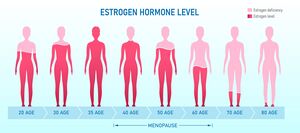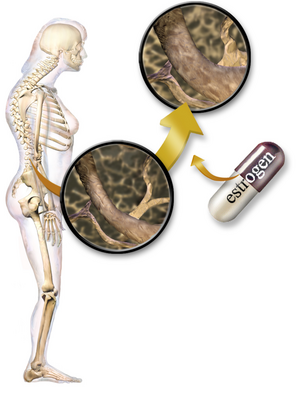Hormone Replacement Therapy: Difference between revisions
Niha Mulla (talk | contribs) No edit summary |
Niha Mulla (talk | contribs) No edit summary |
||
| Line 6: | Line 6: | ||
</div> | </div> | ||
<div class="noeditbox">This article or area is currently under construction and may only be partially complete. Please come back soon to see the finished work! ({{REVISIONDAY}}/{{REVISIONMONTH}}/{{REVISIONYEAR}})</div> | |||
== Introduction == | == Introduction == | ||
Revision as of 00:44, 17 August 2022
Original Editor - Habibu salisu Badamasi
Top Contributors - Habibu Salisu Badamasi, Lucinda hampton and Niha Mulla
Introduction[edit | edit source]
Menopause is a physiological change that occurs in women around the age of 51. Hormone replacement therapy (HRT) combines estrogen with a progestogen to protect the endometrium in women who still have their uterus. [1]Hormone replacement therapy (HRT) is a menopause treatment that relieves symptoms. As you approach menopause, it replaces hormones that are at a lower level.[2]
Types of hormone replacement therapy[edit | edit source]
Hormone replacement therapy (HRT) - most women take a combination of estrogen, progestogen, and estrogen alone.[2] Oral, intravaginal, or transdermal estrogen (oestradiol, oestradiol 17, oestrone, or conjugated equine estrogen) The progestogen can be taken orally, applied topically, or administered through an intrauterine device . Estrogen is used daily in HRT regimens, with progestogen added sequentially (cyclic regimen) or daily (continuous combined regimen) as needed. Tibolone is a synthetic steroid that has estrogenic, androgenic, and progestogenic effects and can be taken as HRT. HRT can be supplemented with testosterone.[1]
- Progestins
- Tibolone
- Testosterone
- Dehydroepiandrosterone
- Custom Compounding
Indications of hormone replacement therapy[edit | edit source]
The presence of bothersome vasomotor symptoms is the main indication for HRT. Vasomotor symptoms are common during the menopause transition and affect about 80% of women, and are severe in about 20% of these women. The duration of these symptoms varies, with a median of four years, but may continue for as many as 12 years in about 10% of women. HRT may be indicated when menopausal symptoms are adversely affecting quality of life.[1]
vasomotor symptoms[edit | edit source]
- Hot flushes
- Night sweats
- with or without awakening.
Benefits of hormone replacement therapy[edit | edit source]
- Menopausal symptoms: HRT is widely used for the established indications of menopausal symptoms.
- Osteoporotic fractures: an older population with severe osteoporosis might have enjoyed greater protection from fractures with HRT. Some studies also found that the use of HRT reduces vertebral and hip fractures.
- Cardiovascular Disease: HRT is used for high cholesterol levels and for coronary heart disease. Hence, for primary prevention of cardiovascular disease.
- Women who use HRT have a significantly lower risk of disease and death than women who do not.
- Breast cancer: The risk of metastases among breast cancer patients who had used HRT was significantly decreased; this suggests that these cancers were localized to the breast and potentially had a better prognosis.
- Colorectal cancer: Studies suggest that estrogen reduces the risk of colorectal cancer. other studies found out that HRT brings about protection of colorectal cancer with increased in duration of use.
- Brain: some studies have found out that may have effect on the brain. A beneficial effect on verbal memory, vigilance, motor speed, and reasoning on symptomatic women.
Risks of hormone replacement therapy.[edit | edit source]
Harms of HRT include coronary heart disease, stroke, and thromboembolism (especially during early use). The risk of breast cancer and cholecystitis increases with longer use.[4]
References[edit | edit source]
- ↑ 1.0 1.1 1.2 Hickey M, Elliott J, Davison SL. Hormone replacement therapy. Bmj. 2012 Feb 16;344.
- ↑ 2.0 2.1 Sullivan SD, Sarrel PM, Nelson LM. Hormone replacement therapy in young women with primary ovarian insufficiency and early menopause. Fertility and sterility. 2016 Dec 1;106(7):1588-99.
- ↑ Benefit of Hormone Replacement Therapy Available from https://www.youtube.com/watch?reload=9&app=desktop&v=Bin4GEf7-TI Accessed on 31/05/2022
- ↑ Grimes DA, Lobo RA. Perspectives on the Women’s Health Initiative trial of hormone replacement therapy. Obstetrics & Gynecology. 2002 Dec 1;100(6):1344-53.








